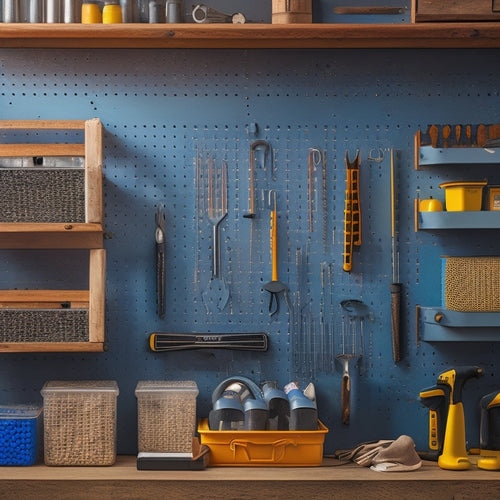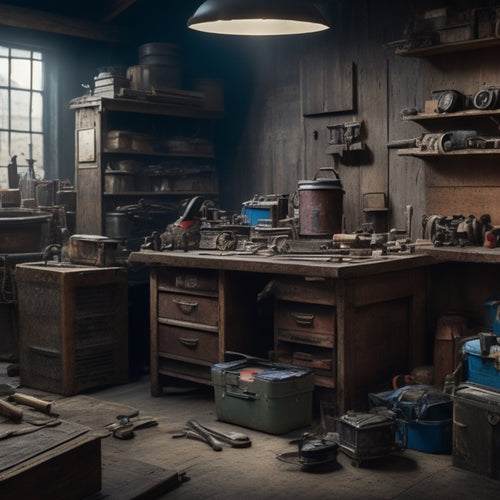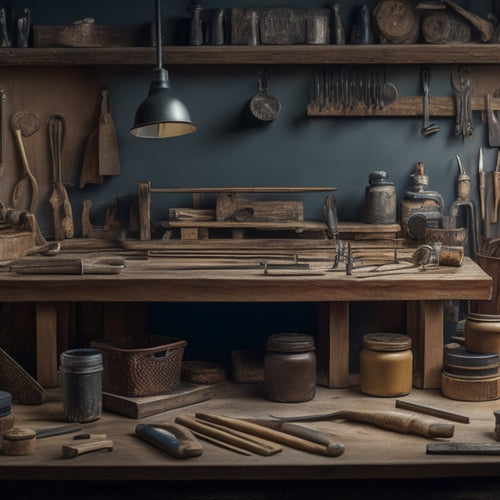
Free Printable Tool Organization Charts for DIY Success
Share
You're taking the first step towards DIY success by searching for free printable tool organization charts. Start by categorizing your tools into groups like measuring, fastening, and cutting, and implement tool rack organization with clear labeling. Maximize your workshop storage by evaluating the layout and utilizing wall space with hooks, bins, or pegboards. A customized pegboard can also help streamline your workflow. By prioritizing essential tools and maintaining them regularly, you'll be well on your way to efficient project completion. Now, take your DIY game to the next level by discovering the remaining vital steps to achieve ultimate organization.
Key Takeaways
• Categorize tools into groups like measuring, fastening, and cutting to create a logical organization system for your toolbox.
• Utilize a pegboard with clear labeling and harmonious color schemes to optimize tool storage and visual appeal.
• Designate specific spots for tools and supplies to streamline your DIY workflow and reduce waste.
• Create a customized pegboard layout based on your workflow, grouping similar tools together for efficient storage.
• Download and print free tool organization charts to help you declutter your toolbox and maintain a productive workspace.
Organizing Tools by Category
Categorizing your tools into groups such as 'measuring and testing,' 'fastening and joining,' and 'cutting and shaping' enables you to quickly locate the right tool for the task at hand. This organized approach saves you time and reduces frustration.
To take it a step further, implement a tool rack organization system with clear labeling tips. For instance, use a pegboard with hooks and bins to store frequently used tools, and label each section with its corresponding category. This visual system allows you to identify the tool you need at a glance.
In addition, consider a tool chest organization system with drawer dividers to keep your tools organized and protected. Divide each drawer into sections using dividers or inserts, and store tools in a logical order. For example, store all your screwdrivers together, followed by pliers, and so on.
Maximizing Workshop Storage Space
With a well-organized tool collection in place, you can now turn your attention to maximizing the storage space in your workshop, ensuring every square foot is utilized efficiently to accommodate your growing DIY arsenal. Start by evaluating your workshop's layout and identifying areas that can be optimized for storage.
Consider installing garage shelving to create vertical storage for less frequently used items, freeing up floor space for more essential tools.
Next, invest in a sturdy tool cabinet to store smaller, precision tools and accessories. Look for one with adjustable shelves and compartments to customize the storage to your specific needs. Label each shelf and compartment to maintain organization and make it easy to find what you need quickly.
Don't forget to utilize the space on your walls by installing hooks, bins, or a pegboard (we'll cover that in more detail later).
Creating a Customized Pegboard
As you set out to create a customized pegboard, you'll need to start by identifying the essential design elements that will make your board functional and efficient.
You'll want to assess the types of peg hooks and accessories that will best support your tool collection, as well as how to optimize storage space to reduce clutter and increase productivity.
Pegboard Design Essentials
Designing a customized pegboard starts with assessing your tool collection and identifying the most frequently used items to ensure efficient storage and accessibility. You'll want to create a pegboard layout that makes sense for your workflow, placing tools in a logical order that reduces clutter and saves time. Take into account grouping similar tools together, such as all your screwdrivers or wrenches, to create a sense of organization and visual appeal.
When planning your pegboard layout, think about the tool placement. You'll want to position your most-used tools at eye level, with less frequently used items stored above or below. This will create a sense of balance and make it easy to access the tools you need quickly.
Don't forget to ponder the pegboard color schemes – a harmonious palette can enhance the visual appeal of your workspace. Choose a color scheme that complements your tools and the surrounding environment, creating a cohesive look that inspires productivity.
Peg Hooks and Accessories
You'll need to select the right peg hooks and accessories to bring your customized pegboard to life, ensuring that your tools are securely stored and easily accessible.
A well-planned peg hook organization is essential for maximizing your DIY project's productivity. When choosing peg hooks, consider the weight and size of the tools you'll be storing. Look for hooks with a sturdy build and a smooth finish to prevent scratching or damaging your tools.
For efficient tool storage solutions, consider adding accessories like bins, baskets, or trays to your pegboard. These will help keep small parts and materials organized, making them easy to find when you need them.
You can also add a pegboard holder for frequently used tools, keeping them within easy reach. By thoughtfully selecting peg hooks and accessories, you'll create a workshop that's both functional and efficient. This will save you time and reduce frustration, allowing you to focus on your DIY projects with confidence.
With a well-organized pegboard, you'll be able to tackle any project that comes your way, knowing that your tools are right where you need them.
Optimizing Storage Space
With your peg hooks and accessories in place, now it's time to think strategically about optimizing storage space by creating a customized pegboard that streamlines your tool organization. A well-designed pegboard can help you maximize your workshop's storage capacity, keep frequently used tools within easy reach, and reduce clutter.
To create an efficient pegboard, consider the tools you use most frequently and group them by category. For example, you can dedicate a section to hand tools, another to power tools, and a third to accessories like sandpaper and drill bits.
Here's an example of how you can organize your pegboard:
| Tool Category | Pegboard Section |
|---|---|
| Hand Tools | Top left |
| Power Tools | Top right |
| Accessories | Bottom left |
| Measuring Tools | Bottom right |
| Fasteners | Middle |
Essential Tools for Every Project
Every DIY enthusiast should have a core set of essential tools that can be relied upon to get the job done, no matter the project. When it comes to tool selection, it's vital to prioritize versatility and reliability.
You'll want to invest in a set of fundamental tools that can be used across multiple projects, such as a cordless drill, level, and pliers. Proper project planning also involves considering the specific tools required for each task, ensuring you have the right tools for the job.
In addition to having the right tools, it's equally important to maintain them properly. Regular DIY tool maintenance is key to extending the lifespan of your tools and ensuring they remain in good working condition. Make sure to clean and store your tools after each use, and perform routine checks for wear and tear.
Safety tips are also crucial, such as wearing protective gear and following proper operating procedures. By combining smart tool selection, project planning, and DIY tool maintenance, you'll be well-equipped to tackle any project that comes your way, while prioritizing safety and efficiency.
Streamlining Your DIY Workflow
When you're working on a DIY project, a cluttered workspace can quickly lead to frustration and wasted time. You'll be more efficient and focused if you clear the clutter and create a sense of order.
Clearing Workspace Clutter
You'll dramatically boost your productivity by tackling the physical and visual chaos that's holding you back, starting with a thorough purge of your workspace. This essential step in streamlining your DIY workflow will help you regain control and focus on the task at hand.
To get started, try these decluttering techniques:
-
Sort and categorize: Divide your supplies and tools into groups, such as 'frequently used,' 'occasionally used,' and 'rarely used.' This will help you identify what's essential and what can be stored away or discarded.
-
Designate a home: Assign a specific spot for each tool and supply, making it easy to find what you need when you need it.
-
Purge the unnecessary: Be ruthless – get rid of anything broken, outdated, or no longer useful. This will help you avoid distractions and stay focused on your project.
Prioritizing Task Sequence
With your workspace organized, now it's time to turn your attention to the tasks themselves, and prioritize them in a logical sequence that ensures you're tackling the most critical steps first. This is where effective task management comes into play.
By prioritizing your tasks, you'll make certain that you're allocating your time and resources efficiently. Start by identifying the most critical tasks that require immediate attention. Break down larger projects into smaller, manageable tasks, and allocate specific tools and resources to each one. This will help you avoid wasting time and energy on non-essential tasks.
To maximize task efficiency, create a project plan that outlines each task's dependencies, deadlines, and required tools. This will enable you to identify potential bottlenecks and optimize your workflow. By streamlining your DIY workflow, you'll be able to complete projects faster, reduce stress, and increase your overall sense of accomplishment.
Decluttering Your Toolbox
Your toolbox is a reflection of your work, and a cluttered one can lead to wasted time, lost productivity, and a higher risk of accidents. A disorganized toolbox can also lead to tool damage, rust, and corrosion, making it necessary to declutter and maintain your toolbox regularly.
Here are three common signs of a cluttered toolbox:
-
Tools scattered all over: You can't find what you need when you need it, and you're left searching for tools amidst the chaos.
-
Duplicated tools: You've purchased multiple tools because you couldn't find the one you already had, resulting in wasted money and space.
-
Broken or rusty tools: Tools are left in disarray, exposed to the elements, and neglected, making them unusable.
Effective toolbox organization and tool maintenance are vital to maximizing your productivity and efficiency. By decluttering your toolbox, you'll be able to quickly locate the tools you need, reduce waste, and guarantee your tools are in top condition.
With a well-organized toolbox, you'll be able to focus on what matters most – delivering high-quality work and serving others to the best of your ability.
Frequently Asked Questions
How Do I Prevent Rust on Metal Tools in My Workshop?
You prevent rust on metal tools in your workshop by storing them in a dry area, wiping them clean after use, and applying a rust-inhibiting coating or oil, ensuring regular tool maintenance and organization.
Can I Customize Tool Organization Charts for Specific Projects?
You can tailor your tool organization charts to specific projects by using customizable templates that allow you to create project-specific layouts, ensuring you have the right tools in the right place for maximum efficiency.
What Are the Best Tools for DIY Beginners on a Budget?
As a DIY beginner on a budget, you'll want to prioritize essential tools, investing in budget-friendly options like a cordless drill and multitool, while also considering clever tool storage solutions to maximize your space and savings.
How Often Should I Clean and Maintain My Tools?
'When in Rome, do as the Romans do' - prioritize tool maintenance! You should clean and maintain your tools daily, wiping down surfaces, and weekly, lubricating moving parts to prevent rust, ensuring they remain in excellent condition.
Can I Use Tool Organization Charts for Non-Diy Purposes?
You can definitely repurpose tool organization charts for non-DIY uses, such as streamlining home organization or optimizing garage storage, helping you create a more efficient and peaceful living space that benefits everyone.
Related Posts
-

What to Look for in a Pegboard Tool Storage Kit
When shopping for a pegboard tool storage kit, you need a system that combines customized organization, sturdy durabi...
-

10 Best Tool Boxes for Every Budget and Job
You're looking for a tool box that fits your budget and job requirements. Whether you're a DIY enthusiast, electricia...
-

Top 5 Small Tool Organizers for Your Workshop
You're looking to optimize your workshop's efficiency with high-quality small tool organizers. Compact storage soluti...


